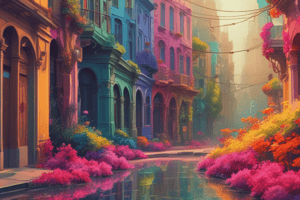Podcast
Questions and Answers
Which of the following colors are considered cool hues?
Which of the following colors are considered cool hues?
- Rust, Brown, Black
- Blue, Violet, Green (correct)
- Red, Orange, Yellow
- Peach, Coral, Golden Brown
Which of the following terms refers to adding white to a color?
Which of the following terms refers to adding white to a color?
- Tint (correct)
- Shade
- Tone
- Intensity
Which of the following skin complexion descriptors denotes a yellowish or pale appearance?
Which of the following skin complexion descriptors denotes a yellowish or pale appearance?
- Sallow (correct)
- Ruddy
- Neutral
- Overtone
Which of the following is the best area for testing foundation?
Which of the following is the best area for testing foundation?
What is the difference between an undertone and an overtone?
What is the difference between an undertone and an overtone?
What is the correct application of blush for a square face shape?
What is the correct application of blush for a square face shape?
What type of facial profile has a prominent forehead and chin, with a recessed middle section?
What type of facial profile has a prominent forehead and chin, with a recessed middle section?
How does the application of blush differ for a long or narrow face compared to a short or round face?
How does the application of blush differ for a long or narrow face compared to a short or round face?
Which of the following is NOT a key point in eye analysis?
Which of the following is NOT a key point in eye analysis?
How would you correct close-set eyes using makeup?
How would you correct close-set eyes using makeup?
What is the purpose of understanding the depth of a subject's face when applying makeup?
What is the purpose of understanding the depth of a subject's face when applying makeup?
Which of the following is a guideline for applying blush?
Which of the following is a guideline for applying blush?
What is the purpose of using dark shades inside and light shades outside when correcting wide-set eyes?
What is the purpose of using dark shades inside and light shades outside when correcting wide-set eyes?
Which of these skin tone correctors is most effective for minimizing the appearance of redness caused by acne or rosacea?
Which of these skin tone correctors is most effective for minimizing the appearance of redness caused by acne or rosacea?
What is the primary objective of using foundation in makeup application?
What is the primary objective of using foundation in makeup application?
What is the key difference between concealer and foundation in terms of pigment concentration?
What is the key difference between concealer and foundation in terms of pigment concentration?
What bone structure is primarily responsible for defining the jawline contour?
What bone structure is primarily responsible for defining the jawline contour?
Which of the following techniques involves using both highlighting and contouring?
Which of the following techniques involves using both highlighting and contouring?
Which of these facial bones is not connected to other bones and allows for movement?
Which of these facial bones is not connected to other bones and allows for movement?
What is the suggested application method for concealer to achieve seamless blending?
What is the suggested application method for concealer to achieve seamless blending?
What is the main purpose of applying skin tone correctors before or mixed with foundation on Caucasian skin?
What is the main purpose of applying skin tone correctors before or mixed with foundation on Caucasian skin?
Flashcards
Hue
Hue
Pure color that differentiates one from another (e.g., red vs blue).
Primary Colors
Primary Colors
The basic colors that cannot be made by mixing others: red, blue, yellow.
Complementary Colors
Complementary Colors
Colors that are opposite each other on the color wheel (e.g., red and green).
Undertone
Undertone
Signup and view all the flashcards
Swatching
Swatching
Signup and view all the flashcards
Order of Application
Order of Application
Signup and view all the flashcards
Objectives of Foundation
Objectives of Foundation
Signup and view all the flashcards
Green Skin Tone Corrector
Green Skin Tone Corrector
Signup and view all the flashcards
Concealer
Concealer
Signup and view all the flashcards
Highlighting
Highlighting
Signup and view all the flashcards
Contouring
Contouring
Signup and view all the flashcards
Mandible
Mandible
Signup and view all the flashcards
Zygomatic Bone
Zygomatic Bone
Signup and view all the flashcards
Three Zones of the Face
Three Zones of the Face
Signup and view all the flashcards
Facial Profile Types
Facial Profile Types
Signup and view all the flashcards
Oval Face Proportions
Oval Face Proportions
Signup and view all the flashcards
Blush Application Guidelines
Blush Application Guidelines
Signup and view all the flashcards
Lighting & Makeup
Lighting & Makeup
Signup and view all the flashcards
5 Points of Eye Analysis
5 Points of Eye Analysis
Signup and view all the flashcards
Corrective Eye Makeup for Close-Set Eyes
Corrective Eye Makeup for Close-Set Eyes
Signup and view all the flashcards
Key Brow Points
Key Brow Points
Signup and view all the flashcards
Study Notes
Color Theory
- Hue: Pure color differentiating one from another (e.g., red vs. blue).
- Intensity: Vividness or brightness of a color.
- Value: Lightness or darkness of a color.
- Tint: Adding white to a color (highest value).
- Shade: Adding black to a color (lowest value).
- Tone: Adding gray to a color (middle value).
- Primary Colors: Red, blue, yellow.
- Secondary Colors: Orange, green, violet.
- Complementary Colors: Colors opposite each other on the color wheel (e.g., red and green).
- Cool Hues: Blue-based colors like blue, violet, and green.
- Warm Hues: Yellow-based colors like red, orange, and peach.
- Skin Complexion Descriptors:
- Ruddy: Red or flushed appearance.
- Sallow: Yellowish or pale appearance.
- Best/Worst Colors for Skin Tones:
- Warm Undertones (Peach/Golden): Peaches, corals, golden browns, rusts work well.
- Cool Undertones (Bluish-Pink, Olive): Blues, violets, cherry reds, and fuchsias are flattering.
- Neutral Colors: Suited for almost anyone, as they aren't strongly blue or yellow-based.
Preparing the Canvas
- Undertone vs. Overtone:
- Undertone: Subtle hue beneath the surface (e.g., warm, cool, neutral) that doesn't change.
- Overtone: Surface skin color that can change with seasons or conditions (e.g., redness, tanning).
- Swatching/Testing Foundation:
- Best Areas: Neck or jawline.
- Avoid testing on: Wrists, hands, or forehead.
- Order of Application:
- Primer/Moisturizer.
- Skin Tone Correctors (optional).
- Foundation.
- Concealer (before or after foundation).
- Powder.
- Objectives of Foundation:
- Protect the skin (often contains sunscreen).
- Even out skin tone.
- Hide imperfections.
- Create a base for makeup.
Skin Tone Correctors
- Green: Cancels redness (acne or rosacea).
- Pink: Brightens dull complexions.
- Lavender: Neutralizes sallowness.
- Yellow/Orange: Corrects blue or greenish under-eye darkness.
- Application Tips:
- For Asian or dark skin tones, always mix with foundation.
- Can be used before foundation or mixed with it for Caucasian skin.
Concealers
- Has higher pigment concentration than foundation.
- Available in various types (pot, stick, tube).
- Uses: Hiding dark circles, scars, pigmentation, and skin conditions.
- Application Tips:
- Apply in a stippling motion (pat to blend).
- Yellow undertones are best for under-eye darkness.
- Use "Hollywood V Technique" for shaping the face.
Contouring & Highlighting
- Main Objectives:
- Highlighting (Matte or iridescent): Brings features forward.
- Contouring (Matte only): Pushes areas back to create depth.
- Sculpting: The Combination of both techniques.
- Common Uses: Correcting facial proportions (e.g., short forehead, receding chin, long nose), Enhancing natural bone structure (cheekbones, jawline, nose, etc.).
Bones of the Face & Corrective Techniques
- Facial bone structure:
- Face consists of 14 bones.
- 13 bones are connected, preventing movement between them.
- Mandible (lower jaw) is the only movable facial bone.
- Key Facial Bones:
- Zygomatic (cheekbones): Essential for contouring.
- Mandible (jawbone): Helps define jawline contour.
- Orbital (eye sockets): Influences eye makeup corrections.
- Temporal (temples): Can be contoured for a slimmer face effect.
Facial Proportions & Zones
- Three Zones of the Face:
- Frontal Zone (Superior/Frontal): Hairline to eyebrows.
- Middle Zone (Median/Sensitive): Eyebrows to nose base.
- Lower Zone (Inferior/Instinctive): Nose base to chin.
- Facial Profile Types: Straight, convex, concave.
- Oval Face Proportions: Width = 5 eye lengths.
Blush Application
- Purpose: Designed to give a healthy glow and serve other purposes.
- General Guidelines:
- Apply from the outer cheek toward the center.
- Use imaginary lines from pupils and the base of the nose to determine placement.
- Application varies based on face shape (long/narrow, short/round, square, heart, pear).
Lighting & Makeup
- Different light sources affect makeup perception.
- Adjust color choices accordingly.
Eye Makeup & Corrections
- 5 Points of Eye Analysis: Size, shape, spacing, balance.
- Corrective Eye Makeup Techniques:
- Close-Set Eyes: Light shades inside, dark outside, extend liner outward.
- Wide-Set Eyes: Dark shades inside, light outside, bring brows closer.
- Deep-Set Eyes: Light on lids, dark in crease, avoid upper liner.
- Protruding Eyes: Matte, dark shades, minimal shimmer.
- Hooded Eyes: Dark on hood, highlight brow bone.
Eyebrows & Corrections
- 3 Key Brow Points: Start, arch, end.
- Corrections: Variations based on nose shape and brow shape.
Key Qualities of a Successful Makeup Artist
- Artistic Skill: Ability to enhance features.
- Client Engagement: Knowledge of trends & product recommendations.
- Observation Skills: Assessing client's best features, skin type, tone, face shape.
Studying That Suits You
Use AI to generate personalized quizzes and flashcards to suit your learning preferences.




